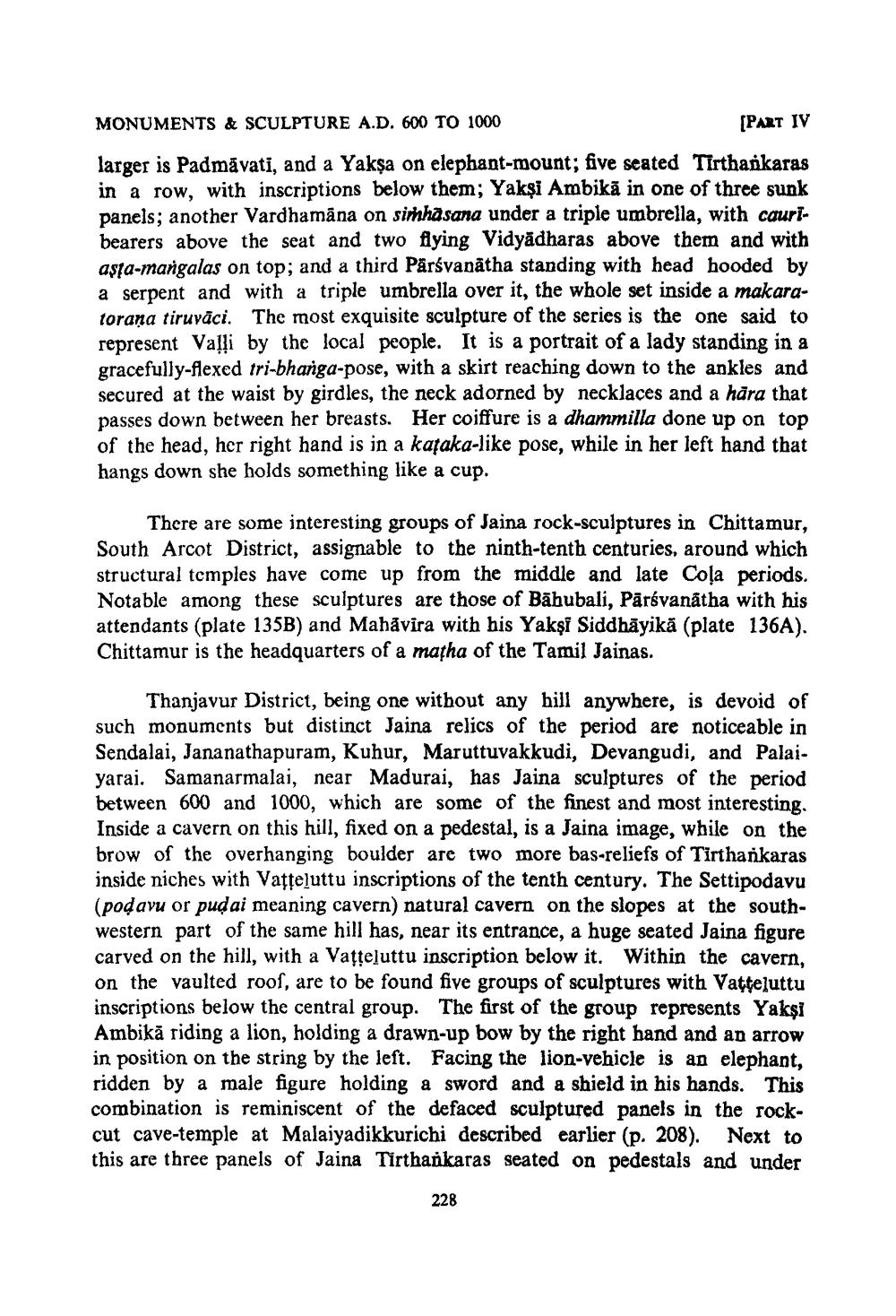________________
MONUMENTS & SCULPTURE A.D. 600 TO 1000
[PART IV
larger is Padmăvati, and a Yaksa on elephant-mount; five seated Tirtharkaras in a row, with inscriptions below them; Yakşi Ambikā in one of three sunk panels; another Vardhamana on simhasana under a triple umbrella, with cauribearers above the seat and two flying Vidyādharas above them and with aşta-margalas on top; and a third Pärsvanātha standing with head hooded by a serpent and with a triple umbrella over it, the whole set inside a makaratorana tiruvāci. The most exquisite sculpture of the series is the one said to represent Valli by the local people. It is a portrait of a lady standing in a gracefully-flexed tri-bhanga-pose, with a skirt reaching down to the ankles and secured at the waist by girdles, the neck adorned by necklaces and a hāra that passes down between her breasts. Her coiffure is a dhammilla done up on top of the head, her right hand is in a kataka-like pose, while in her left hand that hangs down she holds something like a cup.
There are some interesting groups of Jaina rock-sculptures in Chittamur, South Arcot District, assignable to the ninth-tenth centuries, around which structural temples have come up from the middle and late Cola periods. Notable among these sculptures are those of Bahubali, Pārsvanātha with his attendants (plate 135B) and Mahavira with his Yakşi Siddhāyikā (plate 136A). Chittamur is the headquarters of a matha of the Tamil Jainas.
Thanjavur District, being one without any hill anywhere, is devoid of such monuments but distinct Jaina relics of the period are noticeable in Sendalai, Jananathapuram, Kuhur, Maruttuvakkudi, Devangudi, and Palaiyarai. Samanarmalai, near Madurai, has Jaina sculptures of the period between 600 and 1000, which are some of the finest and most interesting. Inside a cavern on this hill, fixed on a pedestal, is a Jaina image, while on the brow of the overhanging boulder are two more bas-reliefs of Tirthankaras inside niches with Vațțeluttu inscriptions of the tenth century. The Settipodavu (podavu or pudai meaning cavern) natural cavern on the slopes at the southwestern part of the same hill has, near its entrance, a huge seated Jaina figure carved on the hill, with a Vațțeļuttu inscription below it. Within the cavern, on the vaulted roof, are to be found five groups of sculptures with Vatteluttu inscriptions below the central group. The first of the group represents Yakşi Ambikă riding a lion, holding a drawn-up bow by the right hand and an arrow in position on the string by the left. Facing the lion-vehicle is an elephant, ridden by a male figure holding a sword and a shield in his hands. This combination is reminiscent of the defaced sculptured panels in the rockcut cave-temple at Malaiyadikkurichi described earlier (p. 208). Next to this are three panels of Jaina Tirthankaras seated on pedestals and under
228




